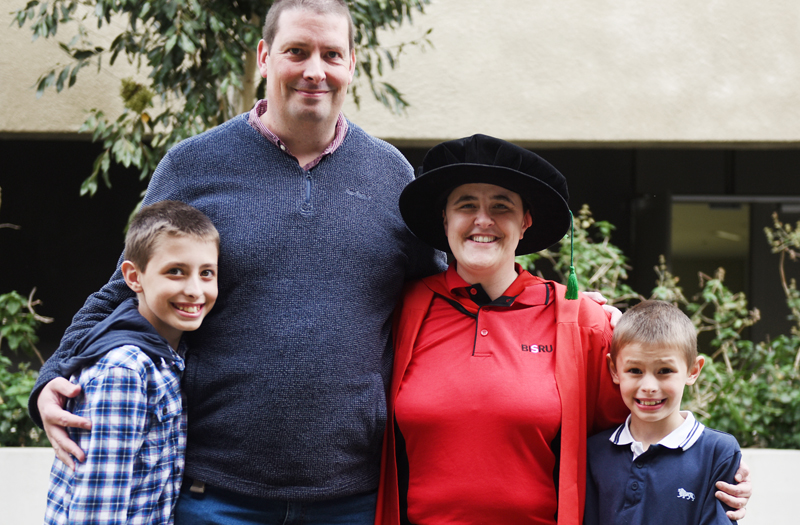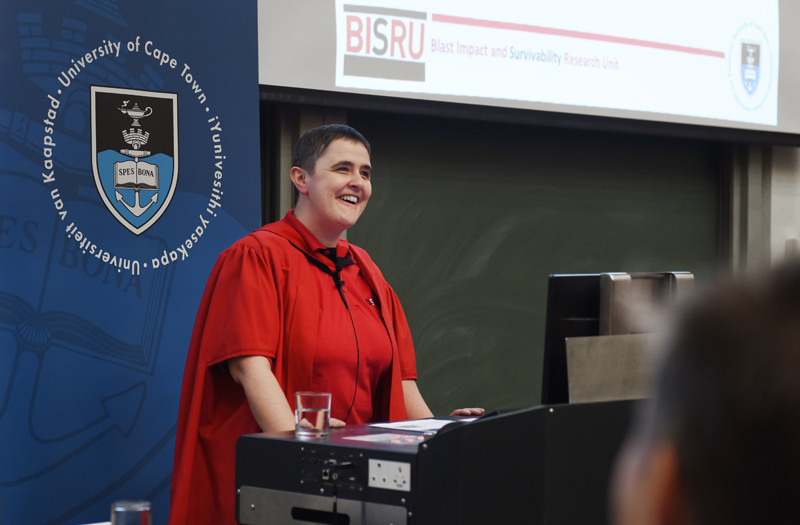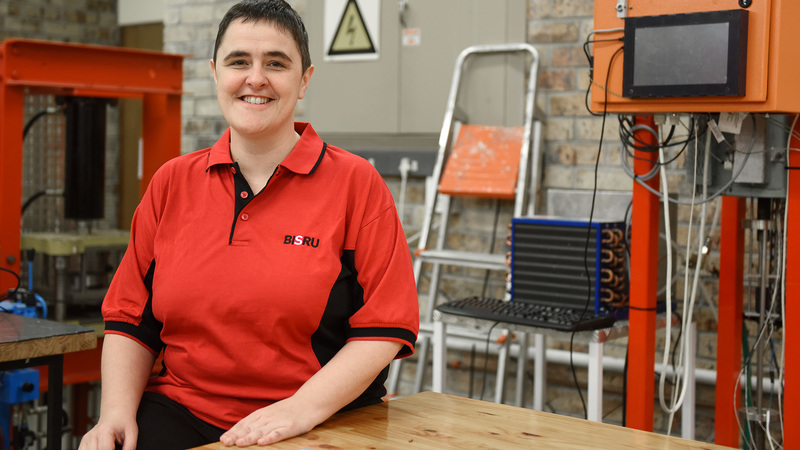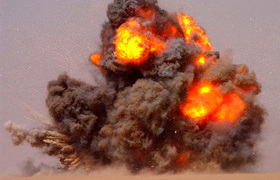Vulnerability at the heart of explosions research
20 September 2017 | Story Helen Swingler. Photos Robyn Walker. Video Saadiq Behardien.In the week of Professor Genevieve Langdon’s inaugural lecture on the effects of explosions, a terrorist bomb sent a fireball through a packed London Underground train at Parsons Green. The “bucket bomb”, or improvised explosive device (IED), failed to detonate properly, probably saving many lives. But it was an unsettling reminder of human vulnerability. The timing seemed uncanny as vulnerability is at the heart of Langdon’s research.
You’d probably never imagine the mother of two with the gentle Liverpudlian accent is a master blaster. But master blaster is one of Langdon’s professional tags. One of only three people at UCT with a blasting certificate from the South African Police Services, Langdon spends her working hours measuring the impact of explosions in a test laboratory at the top end of campus.
Colleagues there are familiar with the sound of a long whistle, followed by a blast. Dean of the Faculty of Engineering and the Built Environment Professor Alison Lewis put it neatly in her introduction to Langdon's lecture: “That’s Genevieve and her team, having a blast.”
Langdon is deputy head of UCT's Department of Mechanical Engineering and director of the Blast Impact & Survivability Research Unit (BISRU). With 93 publications, an H-index of 27 and 2 047 citations, Langdon is also a recipient of the Southern African Association for the Advancement of Science (S2A3) silver medal for outstanding research by a person under 40 years.
In the Faculty of Engineering & the Built Environment, she reflects the ethos of transformation, nurturing and building her students and colleagues and effecting meaningful change to the curriculum.
The eldest of nine children, Langdon grew up on the UK’s largest government housing estate, an area of high unemployment and poverty. Determined that education would be her ticket out of poverty, she completed high school and integrated engineering studies at the University of Liverpool, both on financial aid, and was top of her faculty in honours year.
Her PhD was a study of gas explosions on off-shore structures like oil rigs. She visited UCT as a student and wrote two papers with BISRU colleague Dr Steeve Chung Kim Yuen (both have been cited over 100 times). In 2004 she came to UCT as a postdoctoral research fellow with her husband Gareth and stayed.
Saving lives

An explosion is classified as a very rapid release of energy in a very short space of time.
“We’re talking microseconds,” says Langdon.
That creates a pressure wave that moves outwards and creates much of the damage.
Her interest in the field is not about the rush of the blast. There’s highly complex science and engineering behind explosions. Langdon is interested in using that to save lives by improving the materials that reduce the effects of blasts, whether accidental or the result of criminality, terrorism or war.
In engineering, explosions are not categorised by the activity that causes them (terrorism, mining, accidents) but by their source: the medium that transmits the pressure − through air or water or underground − and how close one is to it. These are the factors that determine the likelihood of damage and survival.
Langdon has spent her career studying two types of explosions: deflagrations and detonations. With deflagrations (usually gas explosions), the blast wave moves slower than the speed of sound. With detonations, the blast wave moves faster than the speed of sound.
“These are the explosions that invoke fear in us: landmines and improvised explosive devices used by terrorists and suicide bombers, and the things we see in war and conflict.”
But the same physics underpins airbags and mining.
“Explosions can be useful if we control them properly and understand them well,” says Langdon.
“Explosions can be useful if we control them properly and understand them well.”
After the blast
What happens after an explosion?
“You get a chemical reaction and hot gas under pressure moves outwards really fast. If the explosion occurs in a container, you get fragments flying off the containers. And if that container carries nails or ball bearings [in a terrorist attack] these can inflict severe injuries, especially if they’re flying at 600m/second, almost Mach 2.
“Often, these objects cause more damage than the blast itself. They’ll put a hole right through you, and even an armoured truck.”
These explosions are very difficult to protect against, says Langdon. The blast wave can create a vacuum that causes glass to shatter outwards. There is also the danger of a fireball, which can create a secondary fire. A reminder of this is the 9/11 attack on the World Trade Center, commemorated the day before Langdon’s lecture.
“It wasn’t the impact of the planes that brought the buildings down, but the fire that weakened the steel inside the structures that caused the collapse.”
In BISRU, she and her team examine and measure what happens to structures during explosions. Two new high-speed cameras linked to a software program not only measure but ‘see’ the effects of the blasts. The first results of this research have been published, heralding what looks like a breakthrough in measuring the movement of structures as it happens – in the first 20 to 250 microseconds of motion.

No Superman suit
Although engineers can’t protect us from explosions, they can help mitigate the effects through prevention, redirection, transformation and obstruction.
Prevention includes airport detection and luggage scans for laptop bombs or concealed weapons. New methods detect even the slightest whiff of explosives. Airport security once stopped Langdon because their machine had detected traces of explosives on her bags. That took some explaining, she jokes.
Redirecting the energy from explosions also prevents serious damage. The V-shaped chassis of a landmine detector vehicle works in this way. Langdon and Chung will often build scaled-down models to understand and test the dynamics of this engineering.
Transformation is another means of protecting against explosions. Essentially, you place something far less valuable than people in the path of possible explosion or impact.
“What you want is material that squashes a lot but carries very little load. Sandwich panels transfer energy but very little load. It crushes and deforms in a certain way during impact.” An example of this is the aluminium honeycomb used in the nose cones of high-speed trains.
Human factor
The downside of her job is dealing with the impact of explosions on human life.
“We can’t really protect you from explosions – the world is really scary. There aren’t any simple answers.”
Instead, society should focus on the inequities that create unemployment and poverty and foster radicalisation, she says.
“Wouldn’t it be better if we developed a better society? That way we can all do explosion prevention.”
 This work is licensed under a Creative Commons Attribution-NoDerivatives 4.0 International License.
This work is licensed under a Creative Commons Attribution-NoDerivatives 4.0 International License.
Please view the republishing articles page for more information.











